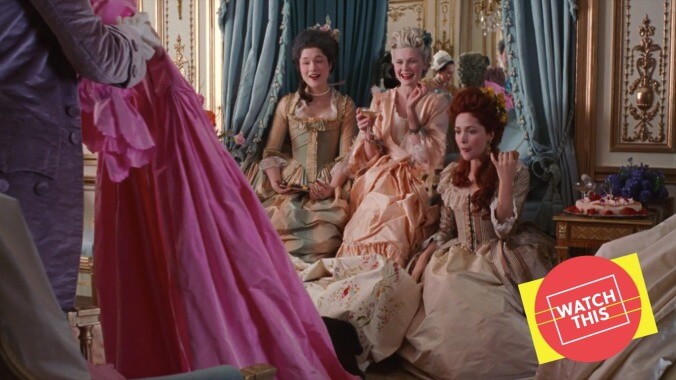Sofia Coppola’s Marie Antoinette was as misunderstood as its teenage queen
Marie Antoinette was the third in a trilogy of films about the inner lives of young women from director Sofia Coppola

Watch This offers movie recommendations inspired by new releases, premieres, current events, or occasionally just our own inscrutable whims. This week: With the release of Gia Coppola’s new movie, Mainstream, we’re highlighting other work from the extended Coppola family.
Marie Antoinette (2006)
The 2000s were a fraught time to be a teenage girl. Countdown clocks to Lindsay Lohan’s 18th birthday, panty shots of Paris Hilton getting out of low-slung Lamborghinis, the intense scrutiny that made Britney Spears shave her head in an act of symbolic rebellion—all of these hovered in the background of girlhood during this era. Now, nearly 20 years later, Britney has been reclaimed from the snarky jokes and leering objectification that drove her to the edge, prompting a reconsideration of the misogyny of the era. And while we’re at it, Marie Antoinette could use a second look, too.
Marie Antoinette was the third in a trilogy of films about the inner lives of young women from director Sofia Coppola, who first paired with star Kirsten Dunst on The Virgin Suicides. That film, Coppola’s debut, was draped in gauzy nostalgia, but Marie Antoinette takes a more irreverent stance from the start. In the opening credits, Gang Of Four’s “Natural’s Not In It” rakes its claws over a tableau of Dunst lounging on a mint-green chaise surrounded by extravagant pink cakes as a maid slips Manolo Blahnik shoes on her feet. This postmodern style of historical filmmaking was not yet common in 2006, and critics and audiences reacted with confusion; a shot of powder-blue Converse casually dropped amid Marie’s bespoke finery is still listed as a “goof” on IMDb. (It wasn’t.)
Of course, adding winking anachronisms to period projects has become a stylish affectation in the years since; it’s just one of the ways that Marie Antoinette’s youthful decadence was ahead of its time. The film’s pastel palette—which, in an appropriately worldly touch, was inspired by a specific Parisian bakery’s macarons—is currently being replicated all over Instagram and interior design blogs. And scenes of Dunst petting lambs and picking strawberries in a frilly cotton dress now read as an ur-text for the cottagecore craze. Every time Elle Fanning looks directly at the camera in The Great, Marie Antoinette’s foot-high hairdo gains another peacock feather, and while Promising Young Woman is more self-consciously edgy, the way it uses femininity as an aesthetic weapon makes it this film’s pissed-off younger sister.
Marie Antoinette is not an angry movie, though it does delight in letting the air out of pompous palace manners. French commentators reacted violently when it premiered at Cannes, annoyed that it failed to capture the political upheaval that led to Marie’s ultimate demise (also not depicted in the film). But this absence is precisely the point, as the excesses of Marie’s cloistered life at Versailles—a litany of surface pleasures no one should apologize for enjoying—serves to highlight the empty shell under the candy coating on the teenage queen’s life. Powerful yet ineffectual, pampered yet neglected, never alone and forever misunderstood, Marie Antoinette epitomizes what Roger Ebert called “the loneliness of being female and surrounded by a world that knows how to use you but not how to value and understand you.” The frivolity and indulgence, Coppola posits, are simply a 14-year-old girl reacting to the absurdity of her circumstances, her youthful spirit stifled by sour-faced social climbers who view her as little more than an empty womb draped in silk ribbons.
This may well be one poor little rich girl instinctually understanding another, as critics of the film have charged. Indeed, Coppola wrote to author Antonia Fraser upon optioning her biography that she could identify with the doomed queen “coming from a strong family and fighting for her identity.” But how many books and films have focused on the disaffection of privileged young men? Are they derided as having cotton candy for brains simply because their heroes are rich and bored? In his dismissive review, Anthony Lane sniffs that Coppola’s notes on the film say “that she sought to capture her heroine’s ‘inner experience.’ Her what? This is like a manicurist claiming to capture the inner experience of your pinkie.” Fifteen years on, it seems that the failure of imagination was not on Coppola’s part but the world’s.
Availability: Marie Antoinette is currently streaming on HBO Max. It’s also available to rent or purchase digitally from Amazon, Google Play, Apple, YouTube, Microsoft, Fandango Now, Redbox, AMC On Demand, and DirecTV.